
It’s no secret that the crypto world is full of various products and services. While most of the attention lies on crypto exchange platforms, lending & borrowing projects, as well as crypto wallets, there’s an entire, huge DeFi market out there, with a lot more to offer! In this Radix review, we’re going to talk about one of the more interesting of these DeFi projects.
Indeed, Radix (or, better known as Radix DLT) is a truly unique crypto-DeFi project that has been in development for a very long time. Granted the unorthodox nature of this project, this Radix review is going to be a bit different than many of my other crypto service reviews.
Looking for a top-tier crypto service provider? Check out Ogvio and enjoy low fees, wide regional availability, and a hybrid fiat + crypto service!
Specifically, to start off, we’ll talk about the Radix crypto platform, from a general perspective, as well as about the benefits that it has to offer to its users. Then, we’ll shift our focus to a specific part of the project - the Radix Scrypto programming language.
Let’s not waste any time, and jump right into it, shall we?
Stop overpaying - start transferring money with Ogvio. Sign up, invite friends & grab Rewards now! 🎁
Pros
- A dedicated DeFi network / ecosystem
- Scrypto - a language for fast dApp creation
- Delegated Proof-of-Stake consensus model
- Sharding - an unlimited scalability solution
- Scrypto is an asset-first smart contract language
Cons
- A complex project, not very beginner-friendly
- Scrypto still isn't fully released
Table of Contents
- 1. Radix Review: PROS
- 1.1. A Decentralized Network for Improving All Aspects of DeFi
- 1.2. 1+1 Native Token - XRD
- 1.3. Top-Tier Security, Passive Income Opportunities
- 1.4. Support for All of the Major DeFi Project Types
- 2. Scrypto - A DeFi-Exclusive Programming Language
- 3. Radix Review: CONS
- 3.1. Scrypto Isn’t Fully Out Yet
- 3.2. A Difficult Model for More-Casual Users
- 4. Conclusions
Radix Review: PROS
So, yes - while we’ll be taking a look at all of the positive aspects outlined in user Radix reviews, this section of the article will also serve as an introduction to the Radix wallet, Radix token, and everything else associated with the project in question.
A Decentralized Network for Improving All Aspects of DeFi
Starting things off, the core question that you probably have is this - what is Radix, and what is it all about?
Well, put simply, Radix is a decentralized crypto network protocol. Specifically, it’s an L1 (Layer-1) decentralized finance solution focusing on all-things-dApps - decentralized applications.
Essentially, the way that you can look at Radix is if you compare it to Ethereum, or specifically - EVM, the Ethereum Virtual Machine, a designated environment that’s dedicated to building smart applications, and publishing them within the ETH ecosystem.

The core goal of Radix is to improve the DeFi sector in every possible way. You’ll likely come across a variety of different user Radix reviews comparing it to Ethereum, specifically, since that’s the current DeFi sector giant. So, in a way, the Radix crypto project, together with all of the elements that make it up, aims to improve on every point of ETH’s functionality, but within its own, separate ecosystem.
How is something like that achieved? Well, in short - with a sum of all parts that make up a well-made and upkept decentralized protocol. In the case of Radix, these parts include:
- The Radix Engine
- Cerberus
- DPoS (Delegated Proof-of-Stake)
The Radix Engine is like the very core of the project, as well as the environment where all smart contracts are executed. The Engine is responsible for all of the processes that happen within the Radix ecosystem, and is what powers the entire project.
Moving on, Cerberus is a “Parallelized BFT Consensus Protocol for Radix”. That’s a super-convoluted way of saying that this is the consensus layer of the project - it’s where all transactions take place, and it’s also responsible for making sure that validator nodes (those that validate new blocks in the chain) work as they’re intended, and there’s no foul play involved.
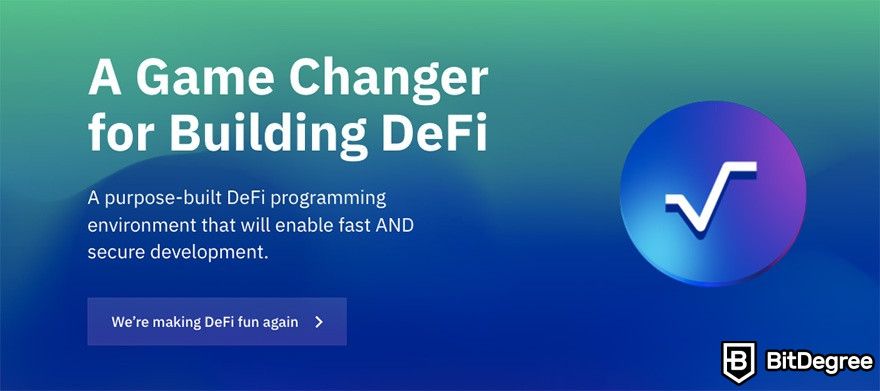
Cerberus is also the layer that’s responsible for the scalability of the Radix crypto project. As you may or may not be aware, scalability is one of the core issues of crypto tech, at present time - it’s also a topic that’s widely explored in some user Radix reviews, and also one that pertains to some major topics surrounding blockchain networks such as Ethereum.
How does Cerberus deal with the scalability question? It’s quite simple, really - learning about what is Radix, you are bound to come across a concept called “sharding”. Blockchain sharding is essentially when the single blockchain network is split into smaller parts, all of which record transactions on their own, and are then brought back into the main blockchain at designated points in time.
Cerberus employs capless sharding - meaning, in theory, the scalability options for the network in question should be unlimited. It’s all but a question of resources, and their allocation.

Lastly, Delegated Proof-of-Stake is a somewhat popular consensus mechanism - it’s the method of how transactions are approved on the network. If you’d like to learn more about it, check out our dedicated glossary entry on the subject.
All of these aspects come together to create the end product - a decentralized protocol with advanced scalability, rewards, and an innovative take on the creation of dApps. These sentiments are present within different user Radix reviews, as well!
1+1 Native Token - XRD
The vast majority of crypto projects - whether it be exchanges, wallets, or decentralized protocols - have native tokens associated with them. Initially, these tokens often serve a crowdfunding purpose, and once the project goes live, they could be implemented in a wide range of methods.
As you look into what is Radix, you will soon learn about the Radix token, as well. Well, rather, I should probably say - Radix tokens. That’s because there are two tokens associated with the project - the XRD coin, as well as e-XRD.
Confused? Allow me to explain.
XRD is the native token to the Radix crypto network. On the flip side, the e-XRD coin is the exact same token, but based on the Ethereum blockchain. While Radix still didn’t have its own, native network launched, its token was located on ETH - when the protocol launched, with its own, native token, the e-XRD Ethereum-based token equivalent remained.

That also works to explain my “1+1” title of this chapter - while there’s really only a single native token, there’s also an ETH-based equivalent, as well.
So, then - what is the Radix coin used for? Well, the asset in question really only has two “designated” uses - it can be staked, as well as used to pay for transaction fees.
Both of these use cases are rather common, with similar crypto projects and their native tokens. You can, naturally, use the XRD coin for actual transactions - that’s still perfectly feasible. However, the Radix token will be crucial for you to pay for your transaction fees, as well as if you want to become a node operator, and validate transactions happening on the chain (in other words - stake your tokens).

Now, where do you store your Radix coins? Well, if you hold e-XRD, then storage options are plenty - since it’s an ERC-20 token, you should be able to store it within most ETH-supporting wallets out there.
On the flip side, if you want to hold the protocol-native XRD tokens, you’ll need to use the Radix Wallet - a special, designated hot wallet that’s designed for this specific purpose. You’ll be able to find the wallet here - it can be downloaded on Windows, macOS, and Linux devices.
Lastly, it’s important to mention the Radix price, too. Both of the tokens are priced almost the same, and have very similar price fluctuations. As of writing this Radix review, the Radix price (for a single XRD coin) is $0,0597, with an all-time high at $0,6538, and an all-time low at $0,0556.

All in all, the Radix token is an essential part of the entire ecosystem - that’s a really cool thing, actually! Sometimes, after the initial crowdfunding round, a project’s native token becomes somewhat trivial, without an actual use case - the very opposite is true with the brand in question, and that’s something that most user Radix reviews agree on, as well!
Top-Tier Security, Passive Income Opportunities
We’ve talked about how Radix works, as well as about the XRD coin and the Radix wallet. Up to this point, though, all of these topics we’re covered from the actual functionality point of view.
There are, however, other points worth considering, as well. Ones that relate to the security, as well as passive earning sides of the project.
Indeed - security is something that any and all crypto-associated projects need to worry about. While it’s most common to talk about the security features (and dangers!) of crypto exchange or wallet platforms, advanced DeFi protocols aren’t an exception, either.
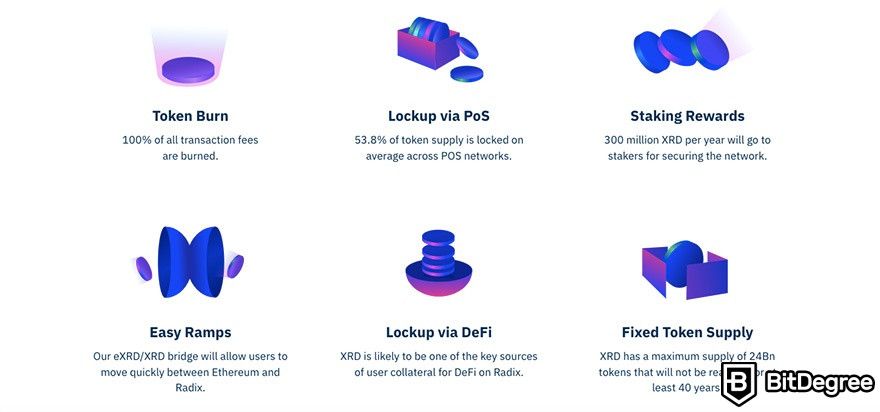
In fact, as of late, this has become a topic of interest to a large part of the DeFi community. As time goes on, more and more networks are shown to have different security vulnerabilities - sometimes, this is the result of white-hat hackers, while other times, the vulnerabilities come out during a major malicious hack.
Naturally, it’s in the best interest of DeFi protocols to employ the strictest security measures possible - user Radix reviews will tell you that this particular project is no different. While Delegated Proof-of-Stake-utilizing projects do tend to have certain “weak spots”, security-wise, the team behind Radix is surely aware of this.
In fact, as of writing this Radix / Scrypto review, there have been no security breaches or other incidents, as it relates to the protocol in question. While the project is still relatively new, it’s a good start - and surely great news for anyone who cares about the security side of the industry!

That said, another point worth making has to do with the staking functionality of the Radix token - XRD. While we’ve covered this in the previous chapter, we’ve only talked about staking as it pertains to the consensus mechanism of the protocol, and the confirmations of transactions. The token does, however, offer passive earning opportunities, as well.
This makes sense, granted that there’s staking involved, in the first place. As you stake your own tokens, from your Radix wallet, you will receive XRD rewards - the actual amounts will differ, and depend on a variety of factors.
Even so, though, if you’re someone who’s actively engaged with the network, or are even a developer who’s looking to use the Scrypto production app, this is certainly a huge added benefit!
Support for All of the Major DeFi Project Types
One thing that I’ve emphasized multiple times already, in this Radix review, is the fact that the protocol in question is designed and created for all-things-DeFi - to be a bit more specific, Radix is intended to be used as a tool to create various dApps, and in doing so, advance the DeFi ecosystem, as a whole.
Well, “dApps” and “DeFi” are some pretty abstract terms. There are examples available of the actual, specific use cases for the network in question!
On their official website, Radix points out all of the potential concepts that you could use their platform with. Notably, in addition to what you might expect (wallets, gaming, yield farming, etc.), there are asset-specific projects included, as well - things such as NFTs and stablecoins.
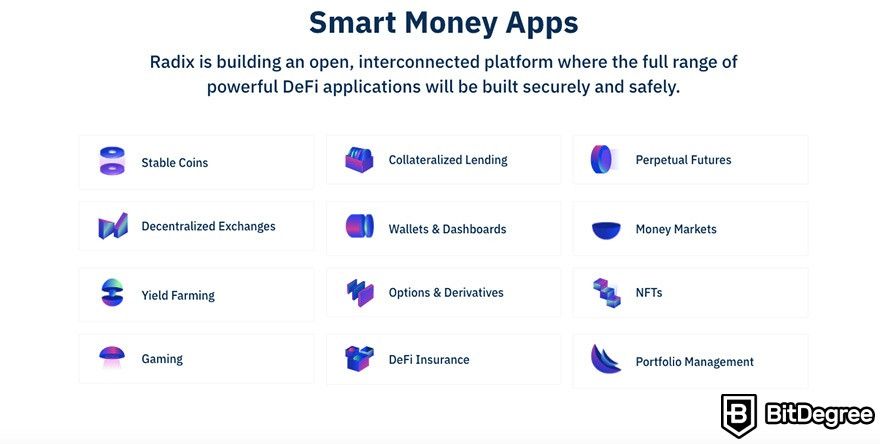
This is very significant! We’ll talk about it more in a second, but this asset-oriented design is part of the Radix Scrypto programming language - its aim is to help developers focus on actual functionality and monetization aspects of their dApps, instead of some difficult network programming.
In a more general sense, the variety of use cases for Radix encompasses all of the major aspects of the realm of decentralized finance. In other words, Radix (the ecosystem) is quite universal - there aren’t really any aspects of the DeFi space that would necessarily be excluded!
All in all, the fact that Radix supports such a huge variety of different DeFi-related use cases is definitely notable! All of the examples help give a better understanding of what to expect from this particular crypto ecosystem.
Scrypto - A DeFi-Exclusive Programming Language
By this point in the Radix review, you should already have a pretty good idea of what the protocol is all about. Now, with some of the key general information out of the way, we do also need to talk about the Scrypto production app - a very special part of the larger Radix ecosystem.
So, what is Scrypto? Well, in a way, it can be considered almost as an entire, separate project from the Radix protocol itself. Don’t get me wrong - they are still very much related to one another! However, Scrypto is huge enough to be a standalone product.
Essentially, Scrypto is a programming language that’s designed and created specifically with a single group of people in mind - dApp (DeFi) developers. In other words, it’s a decentralized finance application-exclusive programming language, built on Rust - a general-purpose programming language.

Immediately, you might say - why would anyone use Scrypto, when there are other, established programming languages for DeFi already?
Well, that’s the point - the entire mission (goal) of the Scrypto production app (or the programming language, as a whole) is to make the process of creating dApps as simple and as approachable (streamlined) as possible! Radix focuses on the actual dApp development part - the issues that developers face, the most common programming language bottlenecks, and so on.
Scrypto aims to address all of that, and then solve it, in its own, unique manner.
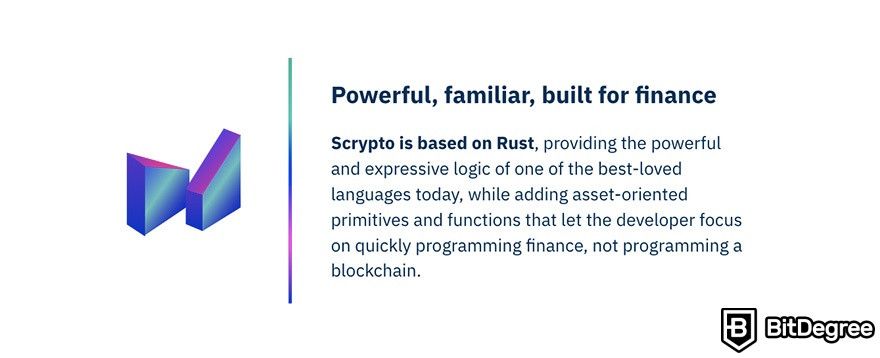
There are a few ways of how the team behind Radix (and Scrypto) aims to achieve this! For starters, as mentioned earlier, Scrypto is based on Rust. This allows for the new smart contract-oriented language to have a robust backing, in addition to adding some tweaks of their own. Specifically, Scrypt is an asset-oriented language - what this means is that developers will be able to focus on the crypto assets (tokens, NFTs, etc.), instead of the actual blockchain network programming.
To add to that, Scrypto is also open-source, as well. While this is something that you’d probably come to expect from a project of this kind, it’s definitely reassuring - being open-source means that developers will be able to come in, and contribute to the code themselves. This will theoretically keep the ecosystem alive and healthy, and bolster community engagement, as well.

In addition to being open-source, some user Radix reviews also point out that Scrypto will feature a reward system. Developers who will contribute to the aforementioned code will be rewarded for their incentives, no matter what size the actual contributions might manifest to be.
All of that sounds awesome, but it’s worth remembering that Scrypto is just part of a larger ecosystem - that of the Radix crypto project. The entire platform is created with the motto “built for builders” in mind, which is one of the best answers to the question - what is Radix?
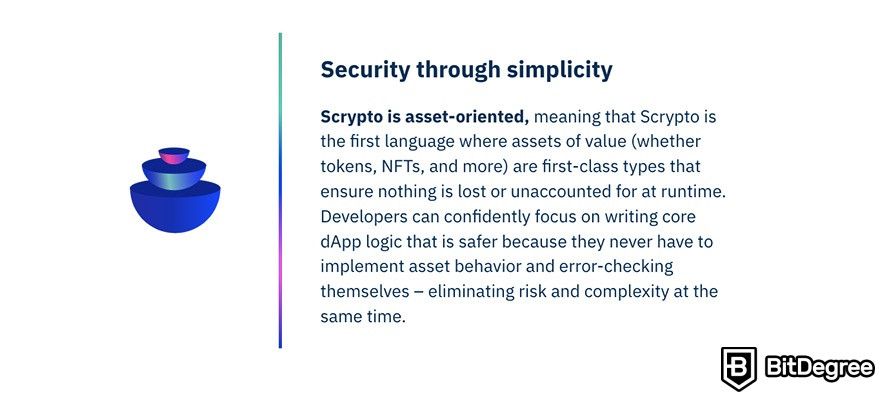
Scrypto, combined with the Radix protocol, are tools that could be used in developing the next generation of dApps. With decentralized finance becoming an increasingly “hotter” topic, as well as it showing more and more signs of mass adoption, this is truly noteworthy!
Currently, Scrypto is available as a Rust package. Any and all DeFi developers who are interested can pick it up, and try the smart contract programming language for themselves!

Did you know?
All Crypto Exchanges may look similar to you but they're NOT all the same!
Radix Review: CONS
So - up to this point in the Radix review, we’ve covered all of the key features of the DeFi protocol in question. Admittedly, it’s a very specific project, geared towards a specific group of people - thus, the Radix feature list is somewhat specific, as well!
Following that, though, and continuing on with this “what is Radix?” article, we should look into some of the less-positive sides of the project. This will help you get a full view of what to expect with Radix, and how your own, personal experience might look with the ecosystem in question.
Scrypto Isn’t Fully Out Yet
If talking about “less-positive” sides of Radix, probably the biggest point that you’ll find mentioned in some user Radix reviews is the fact that Scrypto - the programming language for smart contract development - isn’t really “out” yet.
Now, what does being “out” really mean, in this context?
Well, Scrypto is currently in its early-access stage. Meaning, if you’re a developer who wants to work with DeFi, in any way, shape, or form, and are looking for innovative solutions of how to do so, you could try the language out, for your own project.
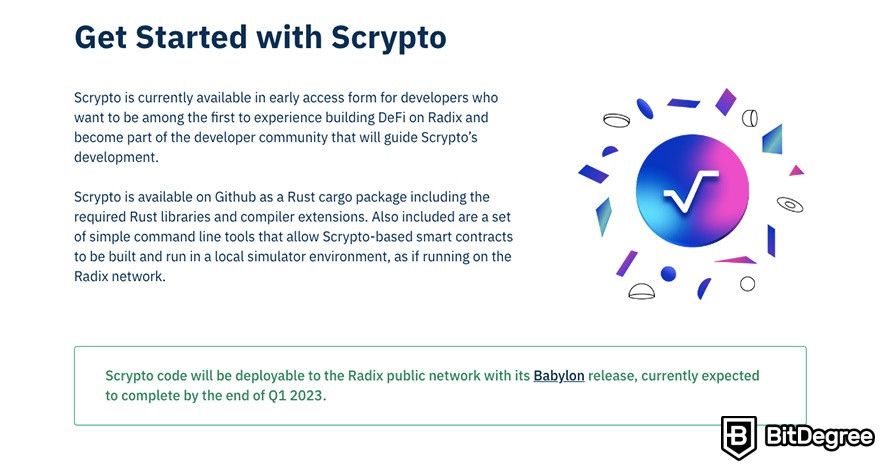
This can be done via a specific Rust cargo package, on GitHub. However, with Scrypto being in the aforementioned early access stage, this also means that you won’t be able to launch that project of yours, or perform any high-end development work on it, either.
On one hand, this is a huge benefit, and a perk - you having the chance to be among the first devs to try out Scrypto for yourself. On the other hand, though, the full launch of the smart contract programming language is set to be somewhere towards the end of Q1, 2023. That’s still some time in the future!
To be fair, this isn’t necessarily a “con”, per se, especially given the fact that there’s a pretty specific point in time set, for when Scrypto will be fully available. That said, if you were looking to start creating legitimate, high-scale and live-version dApp projects with Scrypto already, those plans will have to wait, a bit longer.
A Difficult Model for More-Casual Users
If you’re a casual crypto enthusiast - meaning, you own crypto, and know your way around the industry, but aren’t too tech-savvy when it comes to crypto technology development -, you’ve probably noticed this already. Indeed - Radix isn’t really very approachable, as far as the casual user is concerned.
This is an interesting issue to have, really. In a way, Radix, together with Scrypto, are part of the same, large ecosystem that’s aimed at making DeFi simpler, and much more approachable. This is only true for developers, though - and that makes sense! After all, the target audience (clientele) of Scrypto is just that - DeFi-proficient devs who are looking for process optimization and innovative dApp development solutions.

Furthermore, one could make the argument that while the “more-casual” users may not have an easy time interacting with Radix itself, they would surely appreciate the dApps and other projects built with the help of this network, in regards to scalability, general optimization, and so on.
All of that is fair to assume - however, the original argument still stands, nonetheless! Imagine that you’ve looked into the Radix reviews, and became super-intrigued by the network - you set up a Radix wallet, get yourself some XRD coins, start staking them, and everything seems pretty simple. However, what if you want to participate in additional activities surrounding the project?
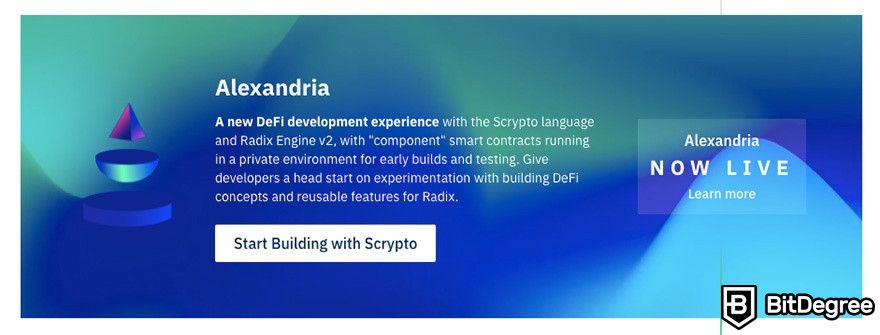
Well, unless you have an app development background, chances are that you’re in for a pretty steep learning curve.
Once again, this is, admittedly, a pretty specific “issue”, when it comes to user Radix reviews. The actual magnitude and significance of this point will depend on your own personal situation! If you do find Radix to be a bit too complex, however, services like Ogvio could present to be worthwhile alternatives!

- Secure and reliable
- Accepts fiat currencies
- Lots of trading options
- Reputable exchange
- Accepts fiat currencies
- Offers various trading options

- Huge trading variety
- Regulation-compliant around the globe
- Fair trading fees
- Beginner-friendly
- A wide array of features
- Vast number of different crypto coins & tokens

- Beginner-friendly
- Secure
- Decent trading and withdrawal fees
- Crypto.com Visa Card
- Automated tools & bots
- Ecosystem synergy with CRO
Conclusions
In this Radix review, we’ve talked about one of the more interesting and unique crypto projects on the current market. Evidently, there are multiple reasons for why you could view the platform that way - it being an advanced (yet still developing) DeFi ecosystem, its unique approaches to solving some of the more significant issues of blockchain technology, the Radix Scrypto smart contract programming language, and so on.
Indeed - there’s a lot to talk about, when it comes to Radix! As you might have also noticed throughout the review, it’s somewhat difficult to paint the project in black or white - pros and cons.
Benefit-wise, Radix has many. It’s an already decently-established network that utilizes its own blockchain, native token, ecosystem logic, and more. The goal of the project, while quite ambitious, is also very clear, and the use cases are many.
On top of all of that, there’s Scrypto - a super-unique approach to making DeFi and dApp development more innovative, simple-to-get-into, and focused on specific goals. It’s definitely very noteworthy!
As far as the project shortcomings are concerned, there aren’t many specific things that would stand out! Naturally, you should keep in mind that, as of writing this Radix review, the Scrypto programming language still isn’t out yet - developers can, however, already try it, via early access privileges.
Apart from that, it’s also worth mentioning that Radix might not be the most approachable crypto project out there, if you’re just a casual investor or a newbie enthusiast - if you’ve read through the entirety of this Radix review, though, you’ve probably already noticed this yourself.
All of that being said, though, would I recommend checking Radix out? Absolutely! If you’re into DeFi, even the slightest, and are looking for some very interesting and unique projects to check out, Radix should definitely be on that list! And, to complement that DeFi experience with a top-notch neobank, feel free to check out Ogvio while you're at it.
Thanks for reading, and until next time!
The content published on this website is not aimed to give any kind of financial, investment, trading, or any other form of advice. BitDegree.org does not endorse or suggest you to buy, sell or hold any kind of cryptocurrency. Before making financial investment decisions, do consult your financial advisor.


